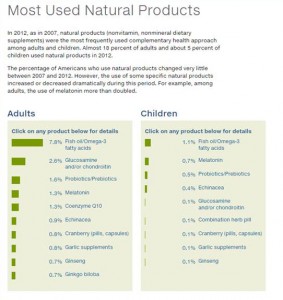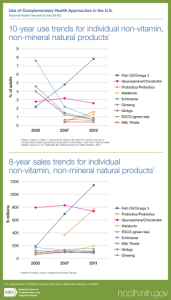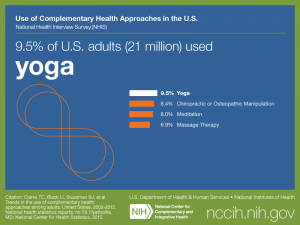 1 in 3 U.S. adults used some form of complementary and alternative medicine (CAM) in the U.S. in 2012, led by fish oil in the herbal supplements category, and yoga in the services category. While use of complementary products and services in health has remained unchanged at about 34% of Americans using CAM, the adoption of yoga in American life has doubled among adults in the past decade to about 1 in 10 adults doing some form of yoga.
1 in 3 U.S. adults used some form of complementary and alternative medicine (CAM) in the U.S. in 2012, led by fish oil in the herbal supplements category, and yoga in the services category. While use of complementary products and services in health has remained unchanged at about 34% of Americans using CAM, the adoption of yoga in American life has doubled among adults in the past decade to about 1 in 10 adults doing some form of yoga.
The report, the Use of Complementary Health Approaches in the U.S., a National Health Interview Survey conducted for the National Center for Complementary and Integrative Health, part of the Centers for Disease Control. The poll results were released on February 20, 2015, and are the most current statistics available on complementary and alternative medicine in the U.S. to-date.
This survey polled 34,525 adults and 10,218 children (4 to 17 years of age) on over 100 practices and products covering the landscape of peoples’ use of complementary health practices in the U.S. in 2012. This database represents the most current statistics publicly available on this subject. This survey was conducted in similar form in 2002 and 2007, against which some trends can be made.
Topics research ranged from “A” for acupuncture to “Y” for yoga — which turns out to be the most utilized CAM mind-and-body service in the market, ahead of massage and other popular services. Dr. Josephine Briggs, who led the research, believes the demand for yoga has dramatically grown with Americans’ interest in mindfulness for use in pain management, especially as a substitute or complement to pharmacological approaches for dealing with back pain. Yoga has pulled in front of chiropractic or osteopathic manipulation as the most-used CAM service since the 2007 survey.
Among herbal supplement trends, increases were found in use of fish oil, melatonin, and probiotics. Demand for Echinacea, glucosamine (with or without chondroitin) and garlic were down.
 Health Populi’s Hot Points: Overall, it appears that American’s use of CAM peaked in 2007, at 35.5% of the population using some form of complementary and alternative health versus 33.3% in 2012.
Health Populi’s Hot Points: Overall, it appears that American’s use of CAM peaked in 2007, at 35.5% of the population using some form of complementary and alternative health versus 33.3% in 2012.
Beyond this macro statistic, there was one visible demographic trend underneath the big number worth calling out regarding older peoples’ growing use of CAM.
The growth of CAM use among people 65+ is stunning, with 3 in 10 older adults now using some form of complementary and alternative health product or service – during a period when the proportion of people under 65 using CAM fell. Are older people more engaged in managing health and quality of life in their older years? This is a hypothesis that’s not tested in this survey, but the data point absolutely suggests something new that’s worth unpacking.
FYI – I asked the researchers a question concerning consumers’ spending for these CAM services the poll did capture but the team’s analysis has not completed; we can expect that report out in “a few months,” we were told on this morning’s webinar. I am continuing to research the impact of the recession on consumers’ health spending, and this component of out-of-pocket spending is an important facet of this ongoing research. Stay tuned!





 Interviewed live on BNN Bloomberg (Canada) on the market for GLP-1 drugs for weight loss and their impact on both the health care system and consumer goods and services -- notably, food, nutrition, retail health, gyms, and other sectors.
Interviewed live on BNN Bloomberg (Canada) on the market for GLP-1 drugs for weight loss and their impact on both the health care system and consumer goods and services -- notably, food, nutrition, retail health, gyms, and other sectors. Thank you, Feedspot, for
Thank you, Feedspot, for  As you may know, I have been splitting work- and living-time between the U.S. and the E.U., most recently living in and working from Brussels. In the month of September 2024, I'll be splitting time between London and other parts of the U.K., and Italy where I'll be working with clients on consumer health, self-care and home care focused on food-as-medicine, digital health, business and scenario planning for the future...
As you may know, I have been splitting work- and living-time between the U.S. and the E.U., most recently living in and working from Brussels. In the month of September 2024, I'll be splitting time between London and other parts of the U.K., and Italy where I'll be working with clients on consumer health, self-care and home care focused on food-as-medicine, digital health, business and scenario planning for the future...